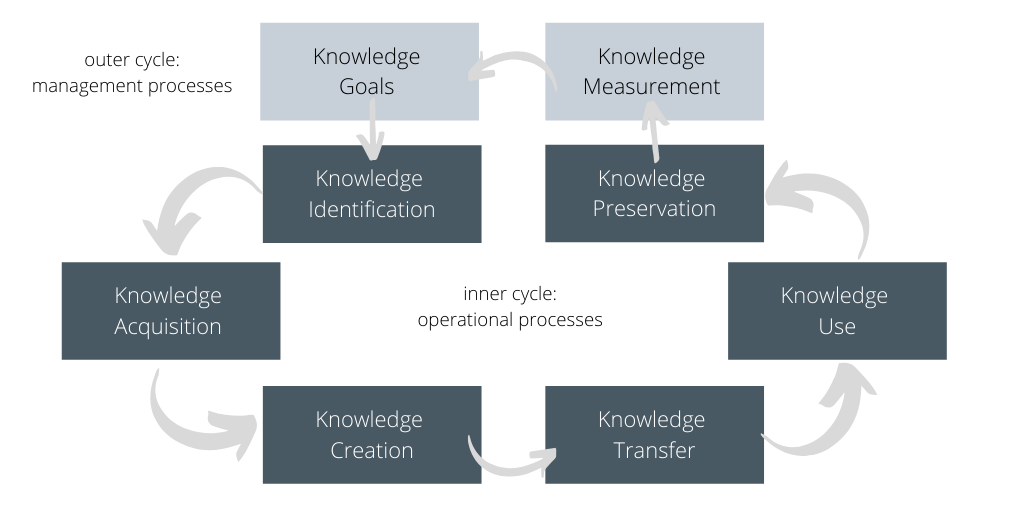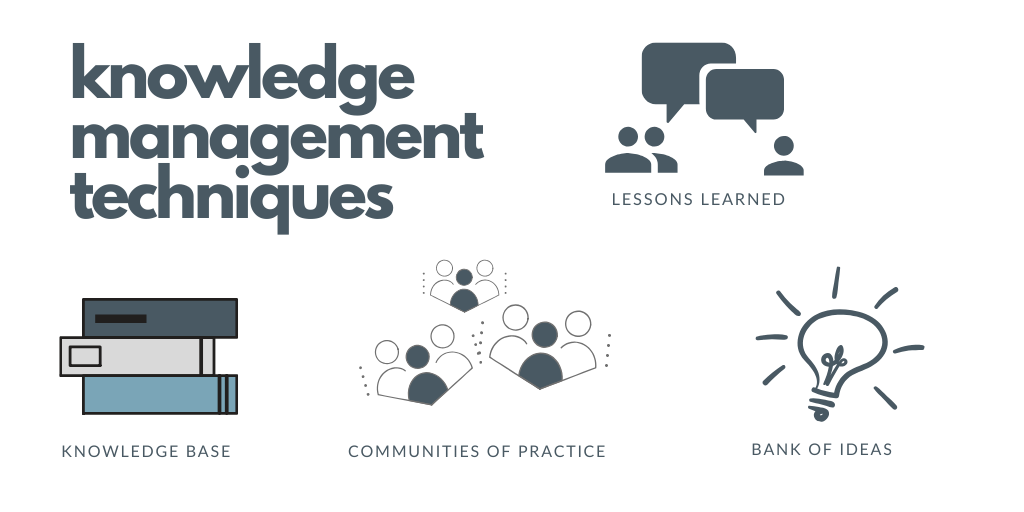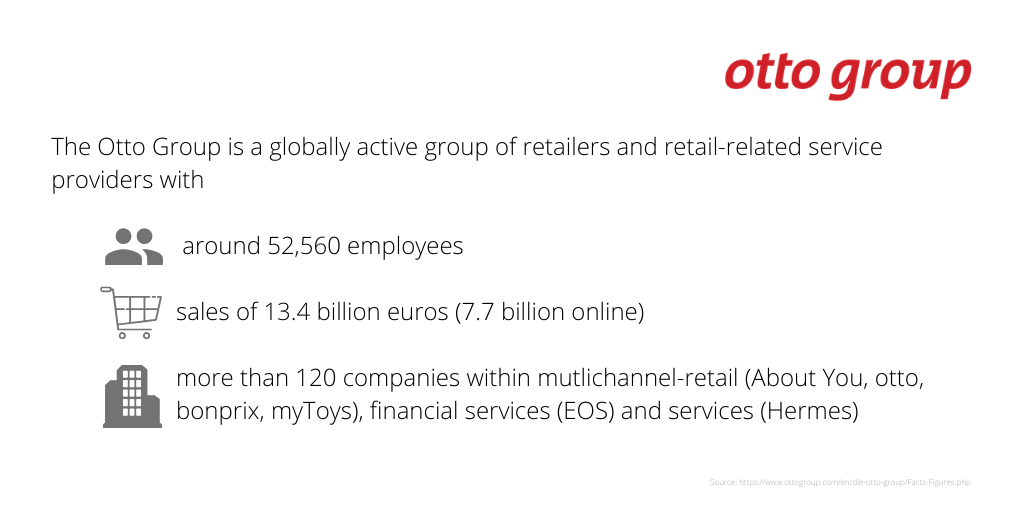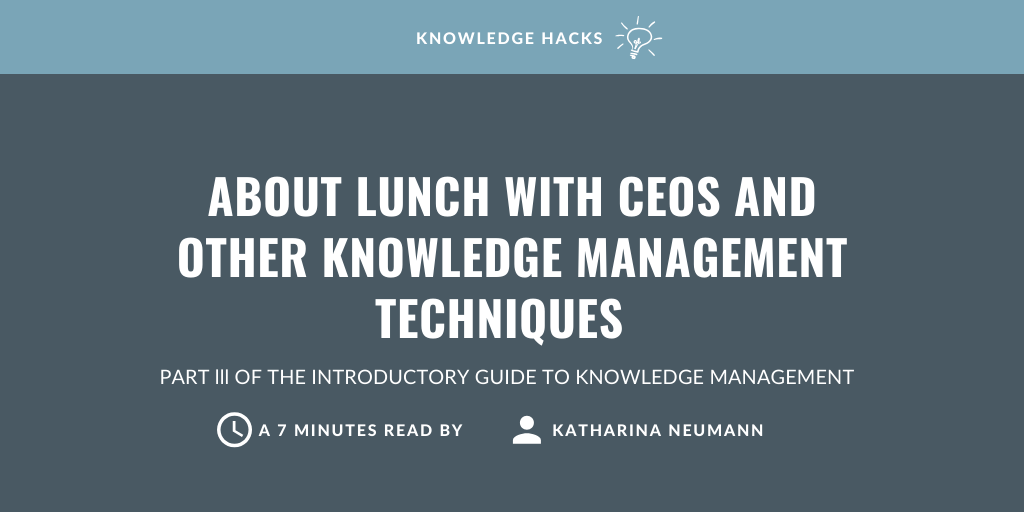Welcome back on the blog to Katharina’s Knowledge Wednesday and the third part of the introductory guide to Knowledge Management.
Did you know that one of the smartest minds in the academic world, who has focused on the topics of managing growth, learning organisations and knowledge management throughout various research projects in his career comes from Switzerland? Now, that I am studying in the home country of one of the Knowledge Management pioneers, I definitely do not want to deprive you of his ideas. We are talking about Gilbert Probst, Professor for Organizational Behaviour and Management and Co-Director of the Executive-MBA program at the University of Geneva, Switzerland. Together with his colleagues Stefan Raub and Uwe Romhardt, Probst developed a model which helps executives and knowledge workers to easily assess their company’s knowledge environment: the eight building blocks of knowledge management.
The Building Blocks of Knowledge Management Model
Just think of the following situation: Johann (65 years) has been working for over 20 years in a company that produces small parts for the automobile industry. His procedural knowledge is extensive and his colleagues often ask him if they are at a loss for a particular order. After 20 years in the same company, Johann goes into his well-deserved retirement. Due to outdated HR processes, a nice farewell party was organised for Johann but a proper handover to younger colleagues was forgotten. What do you think will happen if his colleagues encounter a problem while working on the next orders?
This is only one of many situations, companies face when no concrete knowledge management system is in place. The building blocks of knowledge management model is designed to assess a company’s knowledge cycle and each building block represents one possible field of intervention. In our particular case, described above, I would recommend to have a closer look at the three blocks of knowledge identification, knowledge transfer and knowledge preservation.

But what do these terms stand for? Each building block addresses a core question, companies must ask themselves:
- Knowledge Goals – How do I give direction to my learning efforts?
- Knowledge Identification – How do I create internal and external transparency about the existing knowledge?
- Knowledge Acquisition – What skills do I buy externally?
- Knowledge Creation – How do I build up new knowledge?
- Knowledge Transfer – How do I distribute the knowledge to the right place?
- Knowledge Use – How do I ensure its application?
- Knowledge Preservation – How do I protect myself against loss of knowledge?
- Knowledge Measurement – How do I measure the success of my learning processes?
Four Popular Knowledge Management Techniques
 Knowledge Base
Knowledge Base
If you think of a knowledge base, what is the first idea that comes into your mind? The library you have spent hours and hours writing your thesis? Wikipedia? Your company’s intranet? All these include examples of knowledge repositories. In most cases a knowledge base is part of a company’s or department’s intranet and takes the form of a wiki-based site containing answers to the most frequently asked questions, tutorials and further information on the organization, processes and contact persons. Maintaining a knowledge base can however be time consuming as updating relevant information has to be done on a regular basis and structures within companies grow with time. Attention! Make sure your knowledge base doesn’t develop a life on its own and confuses the reader!
Communities of Practice
A community of practice (COP), as the name indicates, a community or network of people that who share a common interest in a specific topic and certain (best) practices connected with it. You can compare COPs with the various Facebook groups like fan groups for FC Barcelona, Harry Potter, Justin Bieber, cats or the curly girl method, just to name a few. As diverse as the topics are, as much do COPs vary in their characteristics. Some COPs exist for a single event and strive to achieve a specific purpose, others are active for years. Some have only local members, others take a more global approach to membership. As a result, some COPs meet on a weekly or monthly basis, while in others the exchange is purely virtual. No matter the form, a COP is a valuable platform for developing, sharing and managing expert knowledge.
Lessons Learned and Best Practices
Probably most of us have gone through the painful lesson as a child that touching a hot stove is not a good idea. Not all lessons learned have to be negative ones! Sharing best practices i.e. positive news and company successes can also serve as a source of inspiration but usually people can better recall a negative experience. Lessons Learned are the typical “how to do it” knowledge and can be shared in programmed databases. A better approach however is to directly share best practices and lessons learned with people.
Let me illustrate what I mean at the example of the Otto Group:
 The Otto Group possesses huge amounts of data: within the DACH region over 100 online shops produce more than 25 million CRM data pieces (YouGov – Otto Group, 2018). To actually make use of the insights created from the data, an entire department has the mission to spread the existing knowledge among the subsidiaries – each company can profit from best practices of others. Therefore the Knowledge Management Consultants (i.e. the employees of the knowledge management department) organize so called “Best Practice Clubs” (BPC), one to three days workshops where representatives of different subsidiaries share insights about ongoing or past projects and have the opportunity to network and share knowledge. As an intern at the Otto Group, I had the opportunity to help with the organization of three different BPC ranging from e-commerce in Eastern Europe, monetization of online space to digital e- and m-commerce trends. It is particularly impressive that knowledge management has been made a top priority within the Group and that an entire departments is responsible to promote the continuous knowledge transfer under the motto #share&grow (Liesch, 2020). For all German speakers who want to know more about how a knowledge management department works, I can recommend watching this video.
The Otto Group possesses huge amounts of data: within the DACH region over 100 online shops produce more than 25 million CRM data pieces (YouGov – Otto Group, 2018). To actually make use of the insights created from the data, an entire department has the mission to spread the existing knowledge among the subsidiaries – each company can profit from best practices of others. Therefore the Knowledge Management Consultants (i.e. the employees of the knowledge management department) organize so called “Best Practice Clubs” (BPC), one to three days workshops where representatives of different subsidiaries share insights about ongoing or past projects and have the opportunity to network and share knowledge. As an intern at the Otto Group, I had the opportunity to help with the organization of three different BPC ranging from e-commerce in Eastern Europe, monetization of online space to digital e- and m-commerce trends. It is particularly impressive that knowledge management has been made a top priority within the Group and that an entire departments is responsible to promote the continuous knowledge transfer under the motto #share&grow (Liesch, 2020). For all German speakers who want to know more about how a knowledge management department works, I can recommend watching this video.
Bank of Ideas
Knowledge and innovation go hand in hand and who knows the company better than its employees? Having a knowledge friendly culture also means giving employees the opportunity to participate and voice ideas. Within a company I did an internship with, every employee had the opportunity to submit ideas via an idea management systems. All employees could then vote and the best ideas were presented to the Board of Directors and the Works Council for review. This form of participation helped to introduce many positive initiatives, for example, a Mystery Lunch, where you would meet any potential employee for lunch by chance. A lunch roulette that also helps you to strengthen your network within the company and creates knowledge sharing opportunities. Have you ever had lunch with a CEO and/or Head Of a department? Let me know in the comments below!
Now that you are knowledgeable about different techniques companies can use to share their knowledge, you might be curious about the hottest knowledge trends of 2020 – stay tuned for my next posts. Meanwhile, if you haven’t read my previous posts, you can take another deep dive into world of knowledge with: knowledge is power, the difference between data, information and knowledge, as well as 5 benefits of knowledge management!
Bibliography
Hanton, S., & Grassi, V. (2017). Effective Knowledge Management Tools and Techniques. Retrieved 27 March 2020, from https://www.labmanager.com/leadership-and-staffing/effective-knowledge-management-tools-and-techniques-2833
Koenig, M. (2018). What is KM? Knowledge Management Explained. Retrieved 27 March 2020, from https://www.kmworld.com/About/What_is_Knowledge_Management
Liesch, D. (2020). Wissensmanagement bei der Otto Group | wissensmanagement. Retrieved 27 March 2020, from https://wissensmanagement.open-academy.com/wissensmanagement-bei-der-otto-group/
Otto Group: Facts & Figures. (2020). Retrieved 27 March 2020, from https://www.ottogroup.com/en/die-otto-group/Facts-Figures.php
Otto Group unterwegs: Wissen als wirtschaftlicher Erfolgsfaktor. (2014). Retrieved 27 March 2020, from https://www.ottogroupunterwegs.com/blog/blog/posts/Wissen-als-wirtschaftlicher-Erfolgsfaktor.php
Pohlgeers, M. (2014). Knowledge-Management am Beispiel der Otto Group. Retrieved 27 March 2020, from https://www.onlinehaendler-news.de/online-handel/praxistipps/8816-knowledge-management-otto-group.amp
Probst, G., Raub, S. and Romhardt, K., 2012. Wissen managen: Wie Unternehmen ihre wertvollste Resource optimal nutzen. 7th edn. Wiesbaden: Springer Gabler Verlag.
YouGov – Otto Group. (2018). [Video]. Retrieved 27 March 2020, from https://www.youtube.com/watch?v=K39Nfxr08Yc




Hello Katharina,
Wow, what an insightful article! I like the visuals you used, they make it super easy to visualize the information and share your knowledge with us 😉
The Justin Bieber example made me laugh and resonated, in the sense that it shows knowledge management is constant, and it’s not only a professional tool.
I also really liked that you used a real-company example.
The mystery lunch is such a cool idea. I really need to keep it in mind to hopefully make it happen sometimes in my career!
See you next week!
Hi Juliette, thanks a lot for your comment. I even haven’t thought about Justin Bieber in that way, but indeed you have a point with that. The mystery lunches are really interesting – I got to meet so many people from different departments during my internships and it is a bit like speed dating your colleagues which helps you to network and also understand the company better. Definitely something I can recommend.
Thank you Katharina for another super interesting post!
I learnt the term COP while writing my bachelor’s thesis about Business English as Lingua Franca – it was an interesting journey!
Oh that’s cool! I can definitely imagine that there are some communities of practice for business english as well.
Wow, really insightful. The sharing of ” intellectual capital ” is so important for organizations moving forward. Well done Katha.
Thanks for your positive feedback, Cathy! Hope to share more interesting insights in the upcoming weeks!